Difference between revisions of "Thickness of leather"
| (14 intermediate revisions by one user not shown) | |||
| Line 4: | Line 4: | ||
| − | [[ | + | [[Pig leather]] or [[Lamb leather]] are much thinner than [[Cow leather]]. Cow leather is so thick that it is usually split into two usable parts. An un-split cattle skin has a thickness of about 45 millimetres, which is practically impossible to stitch. For this reason, it is not found in the car sector and very rarely in the furniture industry. |
| − | + | To achieve the desired thickness, leather is first [[Split leather|split]] and then [[Shaving|shaved]]. | |
<p align=center> | <p align=center> | ||
| − | [[bild: | + | [[bild:Split leather 001.jpg|500px]] |
</p> | </p> | ||
<p align=center> | <p align=center> | ||
| − | '' | + | ''[[Cow leather]] is usually split into at least two layers.''<br></p> |
<p> </p> | <p> </p> | ||
| − | + | The usual thickness for [[car leather|car]] or [[leather furniture|furniture leather]] is 0.9 to 1.2 millimetres. Leather that is thicker than 1.4 millimetres is called [[thick leather]]. [[leather clothing|Garment leather]] for light leisure jackets has a thickness of 0.5 to 0.9 millimetres. The leather thickness varies depending on the [[Types of leather|type of leather]]. | |
| − | + | Since [[leather]] is a soft material, it is difficult to measure the thickness simply with a calliper. The soft material would be pressed thinner and the results would be different depending on pressure. In the case of standardized leather thickness measuring devices, the thickness of the leather is determined with a predefined area and a predetermined contact pressure. As leather is not uniform in character or content, it is almost impossible to measure uniform results over the entire [[Parts of the hide|surface of a skin]]. The measurement of the thickness of leather is regulated by national and international standards. | |
<p align=center> | <p align=center> | ||
| − | [[bild:Dicke3.jpg| | + | [[bild:Dicke3.jpg|500px]] |
| − | + | ||
</p> | </p> | ||
<p align=center> | <p align=center> | ||
| − | + | [[bild:Dicke1.jpg|500px]] | |
</p> | </p> | ||
| − | <p align=center>'' | + | <p align=center> |
| + | ''Special measuring device to determine the leather thickness.'' | ||
| + | </p> | ||
| + | <p align=center>''Close up view of the scale of the measuring device. The hide of leather in this case was 1.7 millimetres thick.''<br></p> | ||
<p> </p> | <p> </p> | ||
| + | <p align=center> | ||
| + | [[bild:Measuring leather thickness Photo LeatherNaturally.jpg|500px]] | ||
| + | </p> | ||
<p align=center> | <p align=center> | ||
[[bild:Falzen-01.jpg|500px]] | [[bild:Falzen-01.jpg|500px]] | ||
</p> | </p> | ||
<p align=center> | <p align=center> | ||
| − | '' | + | ''During the [[shaving]] process in the [[tannery]], the leather thickness is measured repeatedly (1st photo by [https://www.leathernaturally.org/ LEATHER NATURALLY).''<br></p> |
<p> </p> | <p> </p> | ||
| − | ''' | + | '''In case of [[vegetable-tanned leather]], the following leather articles are produced according to leather thickness:''' |
| − | 1 | + | 1.0 to 2.5 mm: [[Leather wallets|wallets]], [[Leather handbags|leather bags]], [[Leather book cover|book covers]] |
| − | 2 | + | 2.0 - 2.5 mm: robust [[Leather bag|leather bags]], [[leather straps]] |
| − | 2 | + | 2.8 - 3.5 mm: [[Leather belt|belts]], [[shoe leather#Sole leather|soles of shoes]], [[weapon leather#knife sheaths - sword sheaths - saber sheaths|knife sheaths]] |
<p align=center> | <p align=center> | ||
| − | [[bild:Heavy-Duty-Belt-03.jpg| | + | [[bild:Heavy-Duty-Belt-03.jpg|500px]] |
| − | + | ||
</p> | </p> | ||
<p align=center> | <p align=center> | ||
| − | ''Heavy | + | [[bild:Lederhandschuhe-Lammleder-03.jpg|500px]] |
| + | </p> | ||
| + | <p align=center> | ||
| + | ''Heavy duty belt: USA [[Leather belt|belt]] with 6.3 mm leather thickness. - Thin, [[Haptic evaluation of leather surfaces|butter-soft]] [[lamb leather]].''<br></p> | ||
<p> </p> | <p> </p> | ||
| − | == [[ | + | == [[Leather videos|Video]] about [[split leather]] and [[PU leather|coated split leather]] == |
<p align=center> | <p align=center> | ||
| − | <flashow> | + | <flashow>//www.youtube.com/v/eEcF6ez_iVM&fs=1&color1=0x660000&color2=0x550000&border=1|width=500|height=281,25</flashow> |
</p> | </p> | ||
<p align=center> | <p align=center> | ||
| − | ''[[ | + | ''[[Leather videos|Video]] about the [[Leather production|production]] of laminated [[split leather]].'' |
</p> | </p> | ||
| − | |||
| − | |||
| − | |||
== Additional information == | == Additional information == | ||
| − | * [[ | + | * [[Split leather|Splitting]] |
| − | + | * [[Shaving]] | |
| − | * [[ | + | * [[Measures and weights]] |
| − | * [[ | + | * [[Leather quality]] |
| − | * [[ | + | * [[Thick leather]] |
| − | * [[ | + | * [[Furniture leather#Thickness of the leather|Importance of the thickness of leather in furniture upholstery]] |
| − | * [[ | + | |
Latest revision as of 15:59, 25 April 2023
Pig leather or Lamb leather are much thinner than Cow leather. Cow leather is so thick that it is usually split into two usable parts. An un-split cattle skin has a thickness of about 45 millimetres, which is practically impossible to stitch. For this reason, it is not found in the car sector and very rarely in the furniture industry.
To achieve the desired thickness, leather is first split and then shaved.
Cow leather is usually split into at least two layers.
The usual thickness for car or furniture leather is 0.9 to 1.2 millimetres. Leather that is thicker than 1.4 millimetres is called thick leather. Garment leather for light leisure jackets has a thickness of 0.5 to 0.9 millimetres. The leather thickness varies depending on the type of leather.
Since leather is a soft material, it is difficult to measure the thickness simply with a calliper. The soft material would be pressed thinner and the results would be different depending on pressure. In the case of standardized leather thickness measuring devices, the thickness of the leather is determined with a predefined area and a predetermined contact pressure. As leather is not uniform in character or content, it is almost impossible to measure uniform results over the entire surface of a skin. The measurement of the thickness of leather is regulated by national and international standards.
Special measuring device to determine the leather thickness.
Close up view of the scale of the measuring device. The hide of leather in this case was 1.7 millimetres thick.
During the shaving process in the tannery, the leather thickness is measured repeatedly (1st photo by [https://www.leathernaturally.org/ LEATHER NATURALLY).
In case of vegetable-tanned leather, the following leather articles are produced according to leather thickness:
1.0 to 2.5 mm: wallets, leather bags, book covers
2.0 - 2.5 mm: robust leather bags, leather straps
2.8 - 3.5 mm: belts, soles of shoes, knife sheaths
Heavy duty belt: USA belt with 6.3 mm leather thickness. - Thin, butter-soft lamb leather.
Video about split leather and coated split leather
Video about the production of laminated split leather.
Additional information
- Splitting
- Shaving
- Measures and weights
- Leather quality
- Thick leather
- Importance of the thickness of leather in furniture upholstery







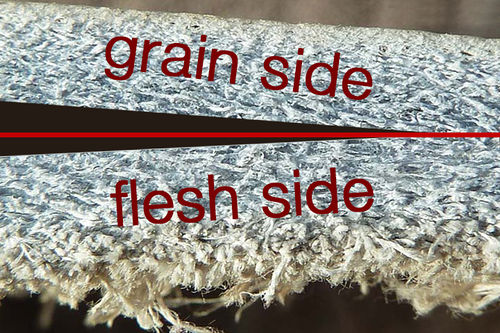
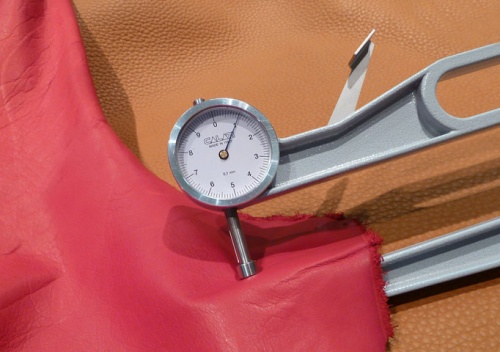
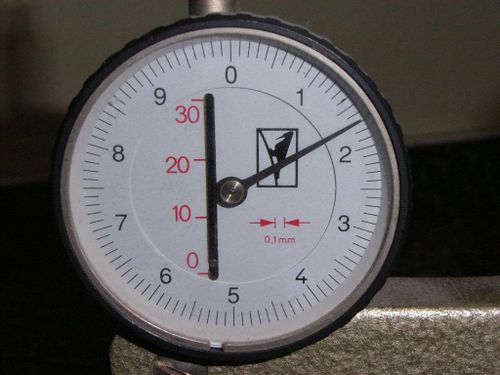
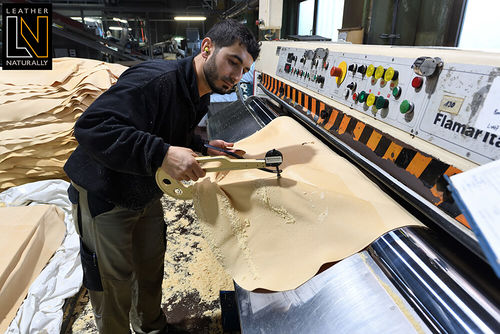
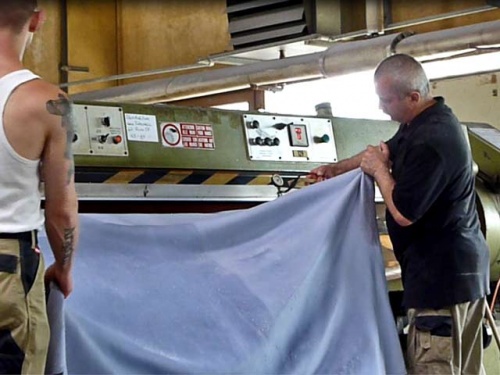
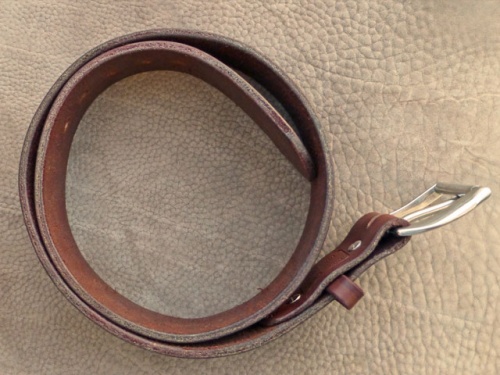
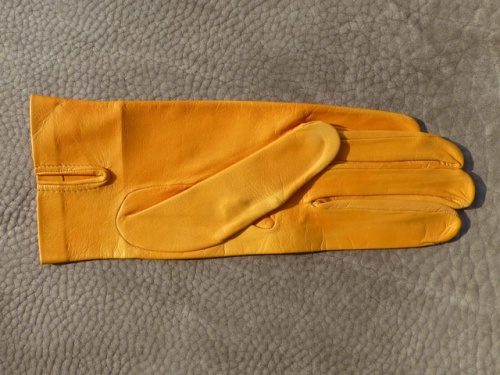

 a kotori web solution
a kotori web solution